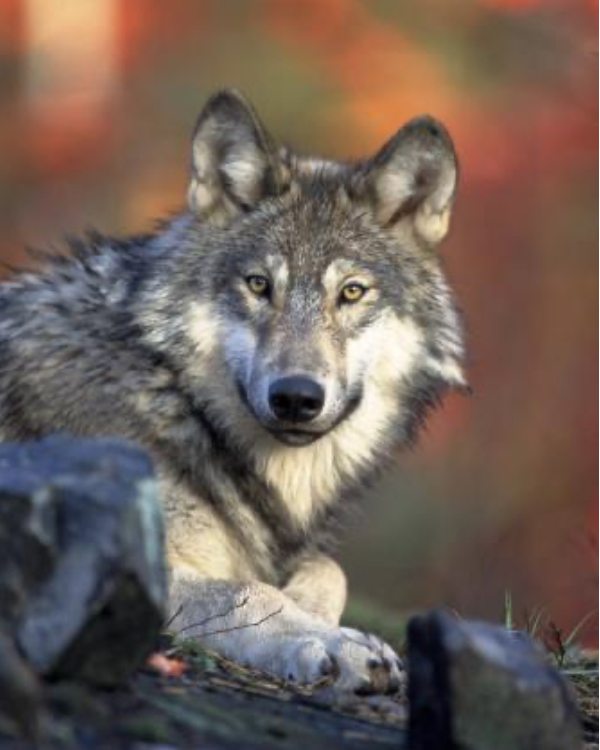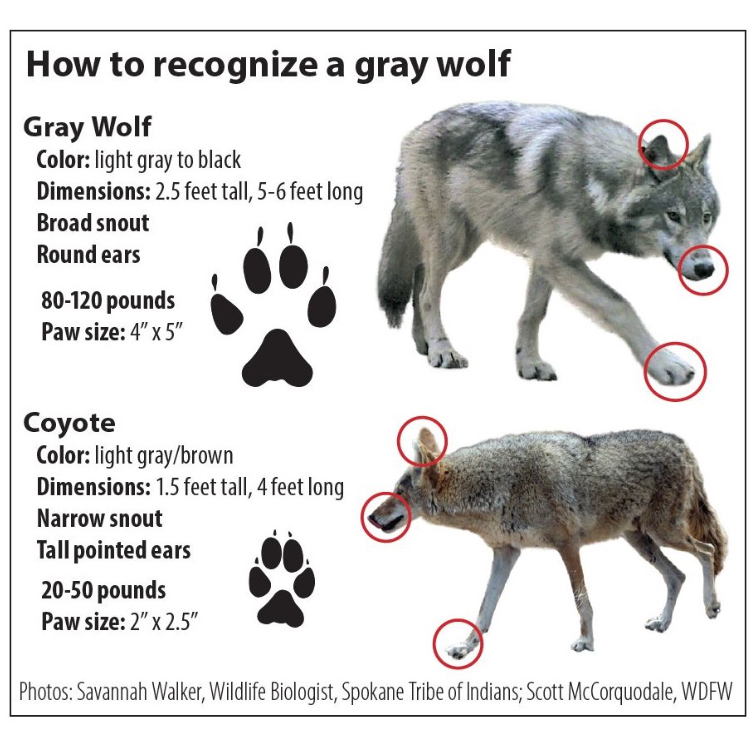Comments welcome until August 16, 2023
information and photos released by WDFW
The Washington Department of Fish and Wildlife (WDFW) is seeking public input on its draft periodic status review (PSR) for the gray wolf (Canis lupus).
Geographic range of first fully documented breeding since the 1930’s was confirmed in July 2008 in Western Okanogan and Northern Chelan Counties
A wolf pack with pups was confirmed in July 2008 in western Okanogan and northern Chelan counties and represented the first fully documented breeding by wolves in the state since the 1930s. Since then, the state’s wolf population has increased at an average rate of 28 percent every year, and many other wolf packs have been confirmed. State and federal wildlife authorities continue to monitor resident wolf activity to assess population expansion across the state and learn more about habitat usage and behaviors.
A wolf pack establishes a territory and defends it against neighboring packs. Territories usually average 140 to 400 square miles, and their size often varies from year to year. Territories are often smaller when prey is more plentiful and other packs live nearby.
Most young wolves leave their birth packs when they are 2 or 3 years old to search for a mate and start a new pack of their own. Dispersing wolves usually relocate about 60 miles from their birth pack, but can travel up to 500 miles or more.
Draft periodic status review process
WDFW’s procedures anticipate wildlife species listed as endangered, threatened, or sensitive will be reviewed every five years to assess available species information and recommend whether the species’ status warrants its current listing or if a reclassification is recommended.
The Department’s draft recommendation is to reclassify wolves from state endangered (defined as seriously threatened with extinction throughout all or a significant portion of its range within the state) to sensitive, which is described as “vulnerable or declining and is likely to become endangered or threatened in a significant portion of its range within the state without cooperative management or removal of threats” under WAC 220-610-110. For more information on the classifications of endangered, threatened, and sensitive species, read WDFW’s blog Understanding conservation categories for species in Washington: Endangered and Protected.
In the western two-thirds of Washington, where wolves are listed under the federal Endangered Species Act, this recommendation would not affect their federal status.

Gary Kramer photo, courtesy of USFWS
“Wolves in Washington have made significant progress toward recovery since their original state endangered listing in 1980, when there were no known breeding wolves in the state,” said Julia Smith, WDFW Wolf Policy Lead. “This draft recommended reclassification to sensitive reflects that progress and most accurately describes the current status of wolves in Washington, while also recognizing that wolves are not yet established in western Washington and should remain protected.”
By the 1930s, gray wolves were essentially eliminated as a breeding species from Washington. In 1980, they were classified as a state endangered species. Since WDFW’s first wolf population survey in 2008, the wolf population has increased for 14 consecutive years by an average of 23% per year. As of Dec. 31, 2022, WDFW counted a minimum of 216 wolves in 37 packs with at least 26 successful breeding pairs.
The draft PSR includes information from a model developed to estimate current and projected future population dynamics of wolves in Washington. The previous model used to inform the Gray Wolf Conservation and Management Plan for Washington was developed using data from wolves in other states as there was not enough empirical data available from Washington wolves for such an effort at the time. The new model is the first effort of its kind developed using data from Washington’s wolf population rather than data from other states.
The Department is not recommending delisting wolves in this draft PSR. Although Washington’s wolf population has far exceeded objectives described in the Wolf Conservation and Management Plan for the number of successful breeding pairs in the state, no successful breeding pairs have been documented yet in the Southern Cascades and Northwest Coast recovery region. However, WDFW documented the first known pack in the Southern Cascades recovery region as of 2022.
Downlisting wolves to state sensitive status would continue to protect them under RCW 77.15.130 and protections precluding hunting would remain in place. WDFW remains committed to the recovery and long-term sustainability of Washington’s wolf population and will continue to work closely with partners, stakeholders, and communities on the recovery, conservation, and management of wolves in Washington, with a focus on reducing conflict between wolves and livestock and achieving statewide recovery objectives.
The draft status review for the gray wolf is available for review at WDFW’s publications webpage. The public is invited to comment by submitting written comments at publicinput.com/psr-gray-wolf, emailing comments to psr-gray-wolf@PublicInput.com or by leaving a comment via voicemail message by calling 855-925-2801 and entering project code 2573. WDFW will accept comments until 11:59 p.m. on Aug. 16, 2023.
All comments received will be considered during the preparation of the final PSR and will inform the Director’s recommendation regarding the classification status of wolves to the Washington Fish and Wildlife Commission. Staff are tentatively scheduled to brief the Commission on the PSR at the August meeting in Olympia, and the Commission is tentatively scheduled to take action on a possible status change at the October 2023 meeting in Olympia, where the Commission could decide to keep the current listing status or change to a different status.

The Washington Department of Fish and Wildlife works to preserve, protect, and perpetuate fish, wildlife and ecosystems while providing sustainable fish, wildlife, and recreational and commercial opportunities.
Individuals who need to receive this information in an alternative format, language, or who need reasonable accommodations to participate in WDFW-sponsored public meetings or other activities may contact the Civil Rights Coordinator by phone at 360-902-2349, TTY (711), or email (Title6@dfw.wa.gov). For more information, see https://wdfw.wa.gov/accessibility/requests-accommodation.








